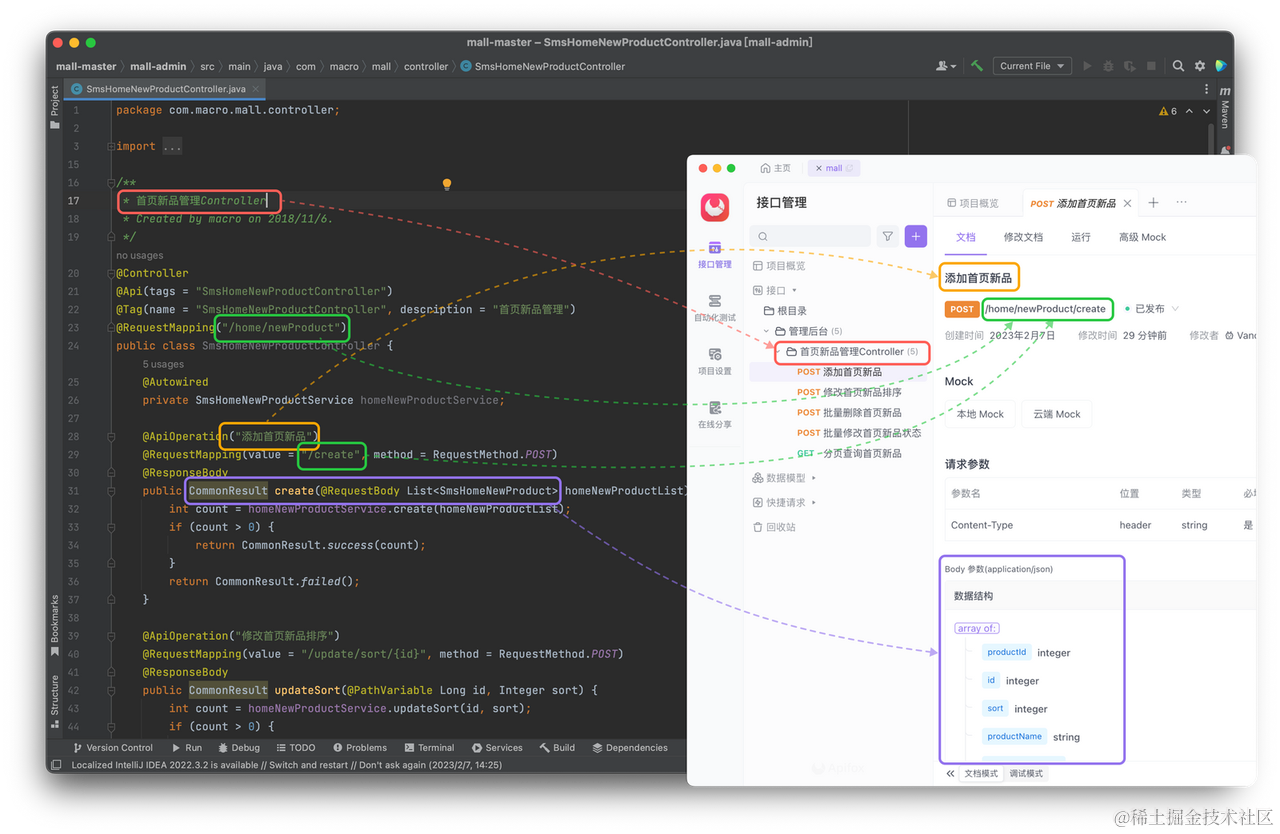使用@ApiModel和@ApiModelProperty的技巧
发布时间:2023年12月19日
在现代软件开发中,提供清晰全面的?API 文档?至关重要。@ApiModel?和?@ApiModelProperty?这样的代码注解在此方面表现出色,通过增强模型及其属性的元数据来丰富文档内容。它们的主要功能是为这些元素命名和描述,使生成的 API 文档更加明确。

@ApiModel?和?@ApiModelProperty?的实际用例
这些注解不仅仅是为了展示;它们在各种情景中都发挥着实际的作用:
- 文档生成:通过这些注解整合模型名称、描述和属性详情,可以简化准确详细的 API 文档编制工作。
- 验证:利用?
@ApiModelProperty?可以定义验证约束,如最大长度或最小值,帮助确保数据的完整性。 - 模型解读:在生成的 API 指南中,
@ApiModel?和?@ApiModelProperty?提供的信息有助于明确展示模型,包括示例和详细描述。
注解应用指南
@ApiModel?的注解用法如下:
| 属性 | 数据类型 | 默认值 | 说明 |
|---|---|---|---|
| value | String | "" | 模型的名称 |
| description | String | "" | 模型的描述 |
| parent | Class<?> | Void.class | 模型的父类 |
| discriminator | String | "" | 模型的鉴别器 |
| subTypes | Class<?>[] | {} | 模型的子类 |
| reference | String | "" | 模型的引用 |
| example | String | "" | 模型的示例 |
另一方面,@ApiModelProperty?的使用注解如下:
| 属性 | 数据类型 | 默认值 | 说明 |
|---|---|---|---|
| value | String | "" | 属性的名称 |
| name | String | "" | 属性的名称 |
| dataType | String | "" | 属性的数据类型 |
| required | boolean | FALSE | 属性是否必需 |
| example | String | "" | 属性的示例 |
| hidden | boolean | FALSE | 属性是否隐藏 |
| allowableValues | String | "" | 属性的允许值范围 |
| access | String | "" | 属性的访问权限 |
| notes | String | "" | 属性的注释 |
| position | int | 0 | 属性的位置 |
实践案例
考虑在一个用户管理系统中的用户模型,需要为其 API 提供清晰的定义。通过为我们的 User 类添加?@ApiModel?注解,以及用?@ApiModelProperty?描述每个属性,我们大大提高了文档的清晰度,使其对开发人员和用户更易于理解。
import io.swagger.annotations.ApiModel;
import io.swagger.annotations.ApiModelProperty;
?
@ApiModel(value = "User", description = "用户模型")
public class User {
? ?@ApiModelProperty(value = "用户ID", example = "1")
? ?private Long id;
? ?
? ?@ApiModelProperty(value = "用户名", example = "john.doe")
? ?private String username;
? ?
? ?@ApiModelProperty(value = "年龄", example = "25")
? ?private Integer age;
? ?
? ?// 省略其他属性的getters和setters
?
? ?public Long getId() {
? ? ? ?return id;
? }
?
? ?public void setId(Long id) {
? ? ? ?this.id = id;
? }
?
? ?public String getUsername() {
? ? ? ?return username;
? }
? ?
? ?public void setUsername(String username) {
? ? ? ?this.username = username;
? }
?
? ?public Integer getAge() {
? ? ? ?return age;
? }
?
? ?public void setAge(Integer age) {
? ? ? ?this.age = age;
? }
}这些注解确保了 API 文档有效地反映了模型及其属性,展示了名称、描述、类型和示例值。这种方法直接导致了一个界定清晰、易于使用的 API 参考资料。
关键注意事项
- 集成相关的?Swagger?依赖并正确配置。
- 注解必须准确定义属性,如名称、描述和数据类型。
- 确保使用?
@ApiModelProperty?的属性可以公开访问,并拥有适当的 getter 和 setter 方法。
关于注解使用的常见问题解答
问1:是否可以在一个模型上使用多个?@ApiModel?注解?
答1:不可以,一个模型应该有一个?@ApiModel?注解。
问2:一个属性上可以应用多个?@ApiModelProperty?注解吗?
答2:虽然一个属性可以有多个?@ApiModelProperty?注解,通常是为了提供不同的描述和设置。
与 Apifox 整合简化 API 管理
尽管 Swagger 很有用,但它使用起来可能比较麻烦,缺乏一些协作安全功能。因此,许多人转向使用?Apifox?的 IDEA 插件,以获得更强的功能和方便。它允许在 IDEA 中自动同步 Swagger 注解到 Apifox,并通过多端同步方便测试和维护。
详细使用教程?:如何使用 Apifox 自动生成 API 接口文档 - 一份详细指南

知识扩展:
参考链接:
- Swagger 官方文档:Data Models (Schemas)
- SpringFox 官方文档:Springfox Reference Documentation
文章来源:https://blog.csdn.net/m0_73898769/article/details/135022570
本文来自互联网用户投稿,该文观点仅代表作者本人,不代表本站立场。本站仅提供信息存储空间服务,不拥有所有权,不承担相关法律责任。 如若内容造成侵权/违法违规/事实不符,请联系我的编程经验分享网邮箱:chenni525@qq.com进行投诉反馈,一经查实,立即删除!
本文来自互联网用户投稿,该文观点仅代表作者本人,不代表本站立场。本站仅提供信息存储空间服务,不拥有所有权,不承担相关法律责任。 如若内容造成侵权/违法违规/事实不符,请联系我的编程经验分享网邮箱:chenni525@qq.com进行投诉反馈,一经查实,立即删除!
最新文章
- Python教程
- 深入理解 MySQL 中的 HAVING 关键字和聚合函数
- Qt之QChar编码(1)
- MyBatis入门基础篇
- 用Python脚本实现FFmpeg批量转换
- 【Python进阶编程】python编程高手常用的设计模式(持续更新中)
- FX110网:警惕让你转战BaseHK的喊单骗局
- cubmx基础操作,hal库基本配置流程之使用 stm32cubmx生成HAL库进行gpio点亮led(stm32h7xx)(超详细,小白教程)
- 微服务实战系列之Dubbo(下)
- Deep de Finetti: Recovering Topic Distributions from Large Language Models
- CSS 纵向扩展动画
- Linux route命令详解
- GC6129 双通道5V高细分步进电机pin-pin MS41929,应用于摇头机,X,Y控制,聚焦控制等产品中
- Linux网络编程---socket编程接口接口函数
- 我是一片骂声中成长起来的专家,RocketMQ消息中间件实战派上下册!!